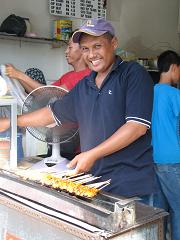
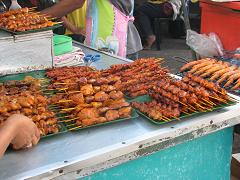
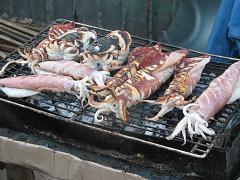
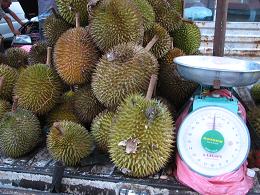
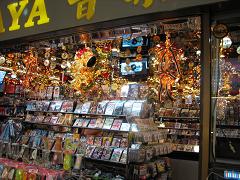
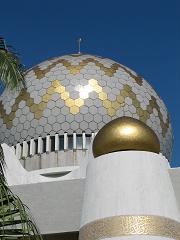
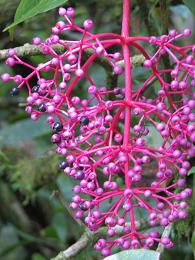
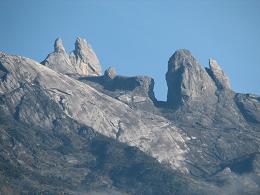

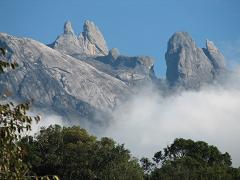 Part Satu (1): Kota Kinabalu
Part Satu (1): Kota Kinabalu
We expected Kota Kinabalu to be a dusty little town at the base of Mt. Kinabalu. Okay, well, nothing is dusty here in the tropics, but we did expect a small town. Though smaller than Kuching, KK is another mostly modern, bustling city complete with Hyatt Regency and spankin’ new Le Meridien hotels, and it is the capital of Sabah state.
There are plenty of air-con shopping malls that provide a cool respite from the heat of the intense fish market, produce markets, Filipino craft market, various outdoor night markets, central market, pearl markets, stuff we don’t understand market, etc…
We’ve been enjoying dim sum from a little food stall/restaurant close to our hotel and made friends with the owners, whose son is getting his masters in electrical engineering from Purdue (U of Indiana). As always, the satay is good and cheap, and we finally learned to order it with a steamed, coconut rice dumpling so we can soak up all the spicy peanut sauce. Alan continues to sample the baked/fried goodies. Aside from the fact that it was dripping with oil, the martabak, a sort of gigantic flat egg roll folded over cabbage and meat was great. He’s still sold on the chocolate and peanut butter filled waffle and the peanut butter filled pancakes. (Sensing a trend here?)
We braved the bustling night food market a couple times. One night, we had a skewer of large prawns (about $1.50) and a skewer of squids the size of shoes ($1.25). Another evening, we went for the noodles and chicken parts. Two wings, two skewers of chicken meat and two skewers of chicken… hmmm.. these little heart shaped things that turned out to be chicken, uh, tails ($1.25).
We took in a few museums including one that happened to have a showing Sabah’s most famous women artists. The historical museum was fairly interesting. Best of all, it was sponsored by Shell Oil so the take on the industry’s “contributions” was a bit skewed to say the least. The city mosque is the second largest in Malaysia (room for 5,000 male worshippers and 500 female worshippers) and would probably be stunning inside when thousands of colorful prayer rugs are unfurled. Unfortunately, we were there between prayer times so it was rather stark and gray. The exterior, without its gold domes and minarets, would look very similar to a multi-level parking lot.
Â
Part Dua (2): MOUNT KINABALU
After a rocky start (no pun intended) — miscommunication with a taxi driver, new bus station that even the tourist office failed to mention, and a shorter-than-expected ride to park headquarters (which had us a bit confused), we arrived in Kinabalu National Park.
It was not a good sign when we were greeted by the friendly park “rangers” — all lovely, young women — in their kacky blouses, skirts and PARKAS. The mountain was completely enshrouded in heavy clouds
We took a mediocre breakfast in the overpriced “canteen”, changed into slightly warmer clothing, and proceeded to take the self-guided hike through the botanical garden. Our cabin wasn’t ready so we signed up for a guided 50-minute hike staffed by a knowledgable young guy.
The little hike proved to be a real treat with lots of information including the difference between bamboo and rattan, a sighting of the world’s smallest orchid (the “Pinhead”) and hints on how to distinguish between vines that discharge water and those giving jungle tranquilizer cocktails. Helpful information, I suppose, if we were ever on “Survivor.”
We proceeded to take another hike on our own. The weather warmed up but everything was still very drippy and wet. No doubt we were in a rainforest.
After a fortifying meal outside the park, we returned to headquarters to collect our bags and hike up the hill to our cabin. There we were greeted by one of the lovely young rangers (who had hiked up in her ranger pumps — honest to god — 1 1/2″ heels) whose job it was to give us a little orientation to be sure we knew how to work everything. (We didn’t think we’re were going to have to learn how to make fire or forage for food, but we were a little concerned that we would need to know how to “work” anything.)
And then she opend the door. Oh my. This was the kind of place where, as our friend Sue Benasso and I would say, “our parents would stay here.” Immaculate, huge, beautiful, polished wooden floors, rattan furniture and built-in furnishings to match. Beautiful woven ceiling, recessed lighting, brand new bathroom with “amenities” (more on those later), and the entire arrangment, whether intentional or not, had very good feng shui.
We rested up and then decided to bypass the less expensive canteen for the restaurant. Gorgeous. A bit like the upper-crust safari lodges in Tanzania, but with impeccable service and MUCH, much better food. I’m not usually willing to pay much extra for ambiance, but this place was worth every ringit. Even in Santa Barbara, this would be the sort of place you’d have to dress up a bit.
Alan decided to supplement his Pepsi with a bottle of their best local Lihing for a whopping 15 ringit (less than $4). Here, at this very classy restaurant, Kinabalu’s rice wine comes in a plastic 500 milliliter bottle with an Avery label probably fresh off the ink-jet. It’s cloudy yellow. Smells like it would strip the paint off your walls. I swear there were fumes. I knew Alan would love it.
We’ve been searching for it in the markets ever since. It’s wonderful. Sort of a fruity sake. We almost forgot our disappointment at not seeing Kinabalu. After dinner we saw a good video about the great granite giant and feared that would be our only viewing of the earth’s newest non-volcanic mountain.
Next morning, 5:30 a.m., video documentarian, Alan Irwin, rises to greet the pre-dawn light. And there it was before him: Gunung Kinabalu — right outside our front door. Reason enough to roust Harriet out of bed at this ungodly hour.
Not unlike other great mountains – Kilimanjaro, Fuji, Rushmore (sorry) — Kinabalu is easy to recognize by its shape. But unlike other more symetrical mountains or even more “average” looking mountains, Kinabalu is a wild, mishapen, mismatched collection of weird thrusts and peaks and juts — like a mammoth half jaw of jagged, crooked, granite teeth.
Totally cool.
The two-day climb to the 4,095 meter summit is supposed to be only moderately difficult — and we could have done it — but frankly, it remains enshrouded in clouds almost the entire climb this time of year. We were happy to view it from the base. And by 8:30 a.m., the entire mountain had disappeared for another day.
Breakfast at the exquisite restaurant, another hike in light rain, and then we headed back to KK.
 Next up: FAQs, Health, Hygiene and other Trivia